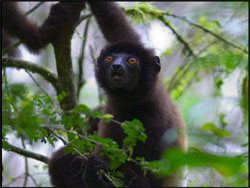Ecology
We aim to understand ecological factors that have contributed to the evolution of longevity in the wild. Dental development is one measure that has been used extensively to estimate maturation rates and ages in mammals, especially in primates. We extend these studies by measuring life-long changes in the structural design of the teeth (dental senescence). Our current focus is on wild mouse lemurs (Microcebus rufus) in Ranomafana National Park, Madagascar and on factors such as parasites in aging lemurs.

Above: Tooth wear in lemurs greatly changes the shapes of the teeth, exposing dentine and changing the length of the shearing blades on the teeth. The length remains fairly high until about 18 years of age, after which it drops precipitously. This age corresponds to when reproductive success greatly decreases.
King et al. (2005) PNAS

